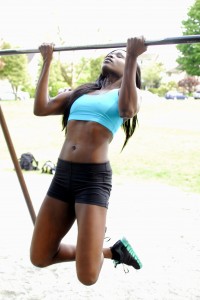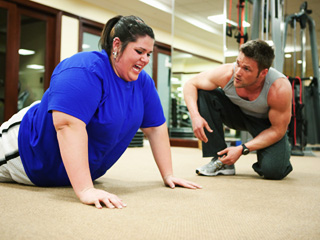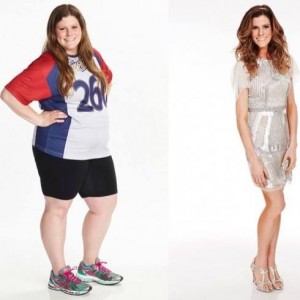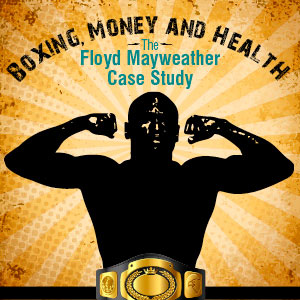For more years than you can count, you have been on a quest for the holy grail of fitness, a unicorn to some. You don’t ask God for much other than the death of your boss, winning the lottery, and a six-pack. Day in and day out, you put in some hard time at the gym. You toiled to no end, but the dreadful gut remained. You took some fat burners and that green tea that Dr. Oz told you about. You would never pass a newsstand and not pick up a fitness magazine covered by a chiseled model with bold colorful writing, telling you about “6 ways to a 6 pack in 6 minutes” or “the best food for flat abs” and read it cover to cover. You’ve been following those fitness gurus on social media talking about waist-trainers, swearing by their effectiveness, and going as far as crediting them for their competition winning mid-sections. You tried everything but alas nothing is happening. Now you are wondering, what really is the 4-1-1 on losing the dreadful stomach pouch and getting that flat stomach or the more elusive 6-pack? I promise you if you read and adhere to my every advice you will have no need to try the latest fad gadget or diet pills.
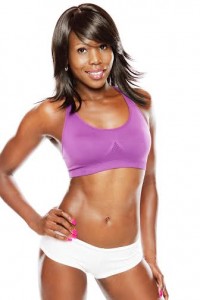 I’m not calling myself a fitness guru, but I just happened to know a thing or two, being a fitness trainer and nutritionist. I have been in the business for a while, and I practice what I preach. Also, I happen to know quite a bit about abs training. I teach a fitness class called Hard-Core and from time to time I sport a 6-pack, or as of right now, I’m working on getting one to sport in the Spring/Summer. So pretty much, I’m in the know about that well kept secret. Yes you read that right, there’s one secret to achieving a fit mid-section …just one. I know what you are thinking, “those sneaky sneaky fitness folks, I totally knew it! Those sons of biscuits”!!! I know right (rolling my eyes). Ok, here’s the secret. Are you ready?! Don’t read ahead or get too excited. Ok Ok…The secret is…there IS NO SECRET! No MAGIC PILL! NOTHING!! Flattening your stomach or building a 6-pack requires a multi-muscles exercise accompanied by cardiovascular training and a diet rich in nutrients. In laymen’s terms, you have to burn some major calories to get rid of that fat and build some serious muscles to get that “toned” look. Very straightforward; no BS!
I’m not calling myself a fitness guru, but I just happened to know a thing or two, being a fitness trainer and nutritionist. I have been in the business for a while, and I practice what I preach. Also, I happen to know quite a bit about abs training. I teach a fitness class called Hard-Core and from time to time I sport a 6-pack, or as of right now, I’m working on getting one to sport in the Spring/Summer. So pretty much, I’m in the know about that well kept secret. Yes you read that right, there’s one secret to achieving a fit mid-section …just one. I know what you are thinking, “those sneaky sneaky fitness folks, I totally knew it! Those sons of biscuits”!!! I know right (rolling my eyes). Ok, here’s the secret. Are you ready?! Don’t read ahead or get too excited. Ok Ok…The secret is…there IS NO SECRET! No MAGIC PILL! NOTHING!! Flattening your stomach or building a 6-pack requires a multi-muscles exercise accompanied by cardiovascular training and a diet rich in nutrients. In laymen’s terms, you have to burn some major calories to get rid of that fat and build some serious muscles to get that “toned” look. Very straightforward; no BS!
First, let’s talk about the anatomy of the abs muscles. There is more to it than just a 6-pack. For many, including my fitness clients, the abdomen has been marginalized to include just one muscle – the rectus abdominis, the part that looks airbrushed on Ryan Goslin. However, the abdominal region is composed of several key muscles that contribute to core function (see figure). 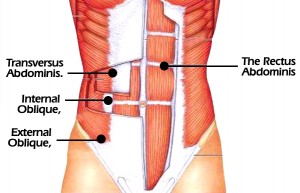 The abdomen is the region lying between the proximal chest and the distal pelvis. This region is served by several muscles that contribute to spine stability in a variety of postures, providing the ability to flex, side bend, and rotate the trunk. These muscles also serve to protect the abdominal organs. Four muscles provide shape and movement to the anterior abdominal wall; these muscles are the obliques (internal and external), transversus abdominis, and the rectus abdominis. Three of these muscles are described as flat muscles (the obliques and the transversus abdominis), and one is described as being straplike (the rectus abdominis). Not to bore you too much with scientific mumbo jumbo, the bottom line is your abs are a part of your core, a very important part of your body, and it’s responsible for so much more than you can imagine, like breathing, coughing, sneezing, and maintaining posture. They are also connected to the muscles of the hips and back so without them there would be no walking to the fridge to grab that ice cream, which you shouldn’t be eating anyway. To train your abs, you have to train your core muscles and pretty much your entire body since everything is connected. You CAN NOT spot train. If you can think you can do millions of crunches every day to get that chiseled stomach, then I’ve got some bad news for you. The only thing you will get is a broken back, literally.
The abdomen is the region lying between the proximal chest and the distal pelvis. This region is served by several muscles that contribute to spine stability in a variety of postures, providing the ability to flex, side bend, and rotate the trunk. These muscles also serve to protect the abdominal organs. Four muscles provide shape and movement to the anterior abdominal wall; these muscles are the obliques (internal and external), transversus abdominis, and the rectus abdominis. Three of these muscles are described as flat muscles (the obliques and the transversus abdominis), and one is described as being straplike (the rectus abdominis). Not to bore you too much with scientific mumbo jumbo, the bottom line is your abs are a part of your core, a very important part of your body, and it’s responsible for so much more than you can imagine, like breathing, coughing, sneezing, and maintaining posture. They are also connected to the muscles of the hips and back so without them there would be no walking to the fridge to grab that ice cream, which you shouldn’t be eating anyway. To train your abs, you have to train your core muscles and pretty much your entire body since everything is connected. You CAN NOT spot train. If you can think you can do millions of crunches every day to get that chiseled stomach, then I’ve got some bad news for you. The only thing you will get is a broken back, literally.
A full body exercise consisting of aerobic and anaerobic activities is required to achieve a strong core by building abs muscles and burning that layer of gut fat to reveal a flat stomach or a sexy 6-pack. A deficit in energy expenditure and caloric intake must be created; meaning besides exercising, you have to mind your diet as well. You have heard the phrase, “abs are made in the kitchen”. In a sense, this phrase is true but not the way you are led to believe. Abs exercises alone are not enough to reduce abdominal fat and the girth of the abdomen, but they are known to increase the strength and endurance of the abdominal muscles. Early results from a 2006 study found that walking exercise (not abdominal exercise specifically) reduced the size of subcutaneous abdominal fat cells. So a combination of the two types is required to take care of the “energy expenditure” part and an excellent diet consisting of nutrients dense food and very low processed food is needed for the “caloric intake” part. In addition, when you build muscle, your basal metabolic rate (the body ability to burn calorie while at res) increases, so in turn you’re impacting the deficit in calories. So you have to work in the gym and the kitchen to achieve your goal. Here’s a sample diet and sample training routine for further illustration. When training abs, we tend to break the exercises down by the four muscles mentioned above; however, in reality the abdomen moves as one. So realistically, every exercise trains the abs.
Sample Training Routine
Back, Abs and Cardio
Romanian Deadlifts 3 sets of 12 reps
T-Bar Row 3 sets of 12
One Arm Dumbbell Row 3 sets of 12 (each arm)
Seated Lat Pulldown 3 sets of 12
Hanging Leg Raise 3 sets of 15 reps
(best for rectus abdominis, upper abs)
Flat Bench Lying Leg Raises 3 sets of 20
(best for transversus abdominis, lower abs)
Bicycles 3 sets of 20 (each side)
(obliques)
Sit-ups 3 sets of 25
(transversus and rectus)
Cardio
16 minutes of HIIT training as explained in my last article, Cardio That Works.
Sample Diet (for 125 lb female)
Meal 1:
1/2 cup oatmeal (dry uncooked)
4 egg whites and 2 whole eggs, 1tsp olive oil.
1/2 blueberries
Snack 1:
2 tbsp peanut butter
1 apple
Meal 2:
Baked chicken breast: 4oz (weigh after cooking)
1 cup spinach
1 tomato
1 avocado
use salad Newman’s Own light salad dressing with olive oil
1/3 cup brown rice (weigh after cooking)
Meal 3:
One baked potato
Salmon 3oz
steamed broccoli 1 cups
Snack 2
1 scoop protein powder
1 cup strawberries
Abdominal fat, and fat cell size in particular, is a predicator of type 2 diabetes and other lifestyle related illnesses like heart disease; therefore it is more than being superficial to make reducing it or eliminating it a priority. While on your quest, there are few rules to keep in mind.
1. No spot training. Train all of your muscle groups at least 3 to 4 times a week accompanied by cardiovascular activity.
2. Diet is VERY important. You cannot out-train a bad diet. No processed or junk food. Eat real food. Some of the best food for fat burning are found in the diet sample above. Oatmeal, eggs, leafy green vegetables, protein powder, nuts/nut butters, olive oil, fruits such as apples and berries, and lean meats.
3. No starvation. The worst thing you can do while trying to lose belly fat is to eat a low calorie diet. Yes a deficit is required but if you restrict caloric intake and send your body into starvation mode, it will hold onto the stored fat for dear life.
4. There is NO magic pill so stay away from fat burners. Let your own metabolism do the work. If energy boost is required, try consuming caffeine an hour before your aerobic exercise, it will spare glycogen and used store fat as energy.
5. Be patient and trust the process. Rome was NOT built in a day.
Good luck and happy training!






